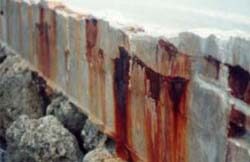
 Did you know that salt water has a corrosive effect on concrete? It is. In fact it is a problem that engineers have been faced with for some time in regards to larger concrete structures like sea walls. Of course sea walls are corroded by much more than salt, such as sand and gravel kicked up and splashed against the concrete.
Did you know that salt water has a corrosive effect on concrete? It is. In fact it is a problem that engineers have been faced with for some time in regards to larger concrete structures like sea walls. Of course sea walls are corroded by much more than salt, such as sand and gravel kicked up and splashed against the concrete.
Salt water itself contains magnesium chloride, sulfate ions and hydrogen carbonation ions that will essentially attack concrete to a certain degree, but what really starts to corrode in a concrete structure is any of the steel substructure within.
Concrete contains an alkaline environment that provides some protection against corrosion. The steel inside the concrete that is used for reinforcement will react with the concrete and form film that protects the steel.
This is where salt water has a corrosive impact. The chloride and sulfate ions will weaken that film as the water soaks into the concrete. Once the film is breached, then the corrosion process begins to work on the steel itself.
Have you ever seen rust stains coming out of concrete? Usually these stains appear around a small fissure or crack. The fissure or crack would have been the most likely place for the salt water to enter.
Because concrete is a type of porous material, oxygen and humidity can be present at the point the salt water has come into contact with the film. This is when the corrosion process of the steel will begin. This is also the point where things can go bad.
Now granted, this is not an overnight process. Generally this process is gradual, but environmental conditions can accelerate the process. Building a holding tank for saltwater aquaria risks this sort of corrosion if not properly protected.
Going back to the steel in the concrete, this being wire mesh of rebar, this normally just a simple carbon steel. When carbon steel corrodes, it expands. Have you ever found something old that’s made of steel that has become all rusty? You recognize the item, but it’s usually a lot bigger than it was when it was new.
The problem with the steel inside your concrete tank is that as it expands, forces will be applied to the concrete structure that causes it to crack. This in turn, leads to more of the corrosion process to begin. At some point, if not cared for, the concrete will totally fail.
As I said earlier, corrosion of this sort will surely destroy concrete over time unless it is properly protected. You need a barrier between the concrete and the salt water that will stop water, chlorides and oxygen from reaching the inner workings of the structure.
Pond Shield epoxy has been formulated to do just that. It has been tested in a variety of corrosive environments, including salt water to ensure that it is capable of performing this important task of protecting the concrete.


